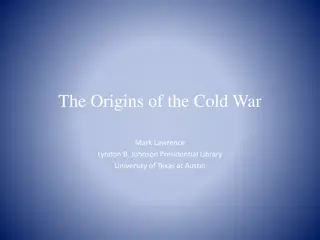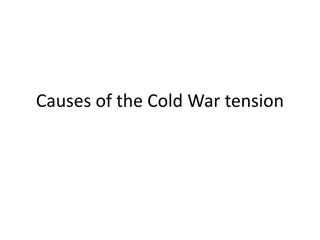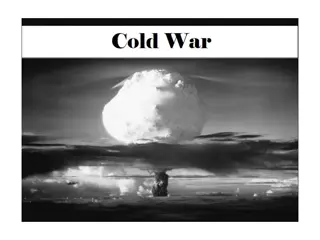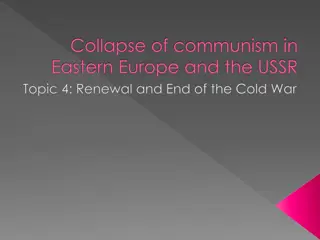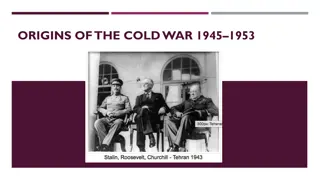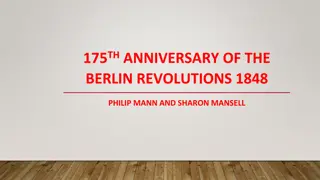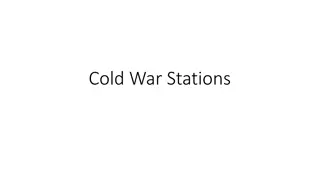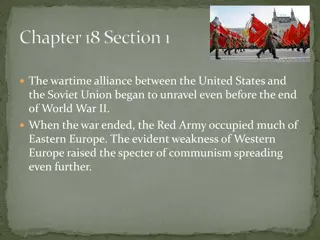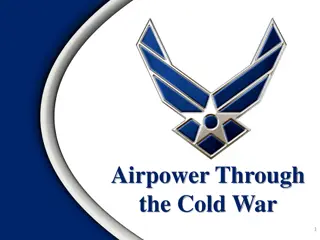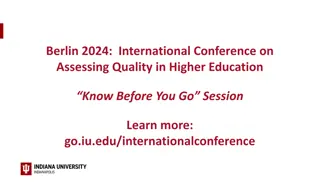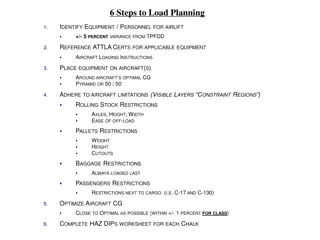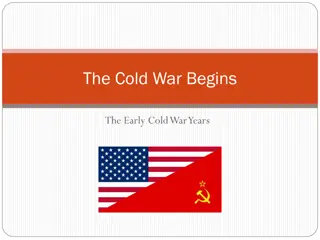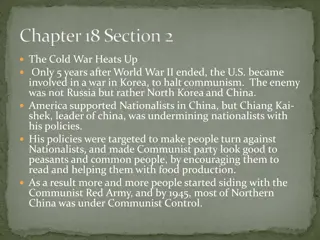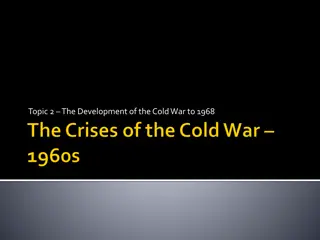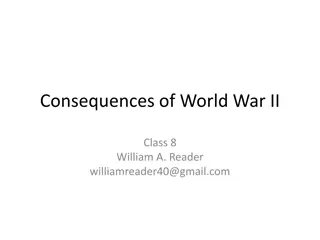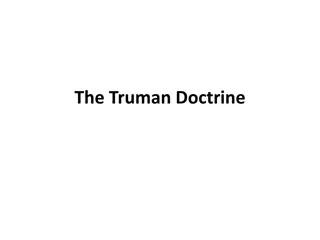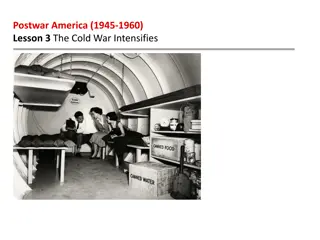Berlin Airlift: A Major Cold War Confrontation
The Berlin Airlift was a pivotal event during the Cold War where the Western allies launched an unprecedented airlift operation to ensure the survival of West Berlin in the face of a Soviet blockade. Lasting for 11 months, it showcased the determination and resilience of the Western powers in supporting the city entirely by air, making it a significant historical and logistical feat.
Download Presentation

Please find below an Image/Link to download the presentation.
The content on the website is provided AS IS for your information and personal use only. It may not be sold, licensed, or shared on other websites without obtaining consent from the author.If you encounter any issues during the download, it is possible that the publisher has removed the file from their server.
You are allowed to download the files provided on this website for personal or commercial use, subject to the condition that they are used lawfully. All files are the property of their respective owners.
The content on the website is provided AS IS for your information and personal use only. It may not be sold, licensed, or shared on other websites without obtaining consent from the author.
E N D
Presentation Transcript
Station A: Berlin Airlift The Berlin airlift marked the first major confrontation in the Cold War. For 11 months, beginning in June 1948, the Western allies took part in an unprecedented attempt to keep a city alive -- entirely from the air. Following World War II, Germany is divided into four zones of occupation -- Soviet, British, French and American. Germany, and Berlin in particular, are the only places where communist and capitalist forces come into direct contact. In June 1948, an announcement by the Western Allies brings a crisis to Berlin. They establish a currency reform meant to wipe out the German black market and further tie the vulnerable German economy to the West. The Soviets are not told and are infuriated by the action. On Thursday, June 24, 1948, West Berlin wakes to find itself under a Soviet blockade -- and in the midst of the first major confrontation of the Cold War. The Western Allies impose a counter-blockade on the Soviet zone. The Soviets hope to starve the West out of Berlin. In West Berlin, the airlift brings people sustenance and hope. In one memorable instance, the airlift rains candy on West Berlin's desperate children. As it became evident that the Soviets are not going to back down from their blockade, the Western Allies considered how to expand their airlift operations. Larger cargo planes were brought in, as well as bombers with cargo capacity The Soviet Union ended its blockade of Berlin on May 12, 1949. A month earlier, at the airlift's peak, Western cargo planes were landing at one of Berlin's three airports at a rate of one every 62 seconds. By the time the airlift ended, more than 275,000 flights had carried 2.3 million tons of supplies to Berlin -- an effort that went down in history as an aviation and logistical feat.
Station A: Your Task 1. Read the description of the Berlin Airlift. 2. Examine the pictures and map of the Airlift. Write your observations about pictures. 3. Then, look at Cartoon A and Cartoon B: A. What is the artist purpose in these two cartoons? B. What do you think the artist thought about the Berlin airlift in these cartoons? C. Do you think that this feeling is similar to the opinion of the rest of America? Why or Why not? D. Which cartoon do you think is more accurate? Why?
http://www.trumanlibrary.org/teacher/berlin. htm#source
Station B: Korean War The surrender of Japan at the end of World War II also meant an end to 35 years of Japanese occupation in Korea. As they had in Germany, Soviet and U.S. troops liberated Korea -- and agreed to divide the nation along the 38th parallel as a temporary measure. But as both sides withdrew their troops, they also set up rival governments, creating the Democratic People's Republic of Korea in the North, and the Republic of Korea in the South Both North Korean leader Kim Il Sung and his South Korean counterpart, Syngman Rhee, dreamed of reunifying the peninsula under their respective governments. But Kim acted first. He pleaded with Stalin, who -- after first rejecting the idea -- helped North Korean forces plan for the invasion of the South. Stalin also was heartened by the communist victory in China in 1949 and believed it was time to open an Asian front against capitalism. On June 25, 1950, the North Korean army rolled south in a surprise assault. The United States took advantage of a Soviet boycott of the United Nations to have the U.N. Security Council condemn North Korean aggression -- and create a U.N. military force that would defend South Korea.
That U.N. force included soldiers from 16 nations, with the largest contingent coming from the United States --- all under the command of U.S. Gen. Douglas MacArthur. At first, the U.N. troops were helpless against the North Korean assault -- and for a while appeared on the verge of being driven from the peninsula. But a daring attack behind North Korean lines at the port of Inchon rolls back the North Korean advance. North Korea's neighbor, the People's Republic of China, watched with alarm as U.N. forces drove the North Koreans out of the South. MacArthur assured U.S. President Truman there was no possibility of China entering the war. But unknown to Western leaders, 500,000 Chinese -- called the People's Volunteers -- were preparing to enter Korea. In November 1950, after repeated warnings through diplomatic channels, China attacked -- sending the surprised U.N. forces reeling southward. U.N. troops stopped the advance by North Korean and Chinese forces near the 38th parallel -- and the war developed into a painful stalemate. MacArthur, who had called for the bombing of Chinese cities (including the atomic bomb) and pursuit of the war into China, was dismissed by Truman. By the summer of 1951 armistice talks began. It wasn't until July 1953, after months of pointless fighting and the death of Soviet dictator Joseph Stalin, that a cease-fire was finally agreed to. Despite the armistice, the Korean peninsula remains divided to this day -- and a potential global flashpoint.
Station B: Korean War Your Task 1. Read the information about the Korean War. 2. Then look through the photographs and maps. A. Do you notice any differences about the armed forces in this war? B. In looking at the maps, what area does the conflict center around? 3. The Korean War is often called the forgotten war. Why do you think this conflict is not as widely known by Americans?
1. The Invasion: North Korean forces cross the 38th Parallel in an attempt to reunite the country under Communist Rule. 2. The Counter Attack: United Nations forces push the North Korean forces back. UN forces travel beyond the 38th Parallel. 4. Armistice: An end to the fighting is decided. Korea remains divided between Communist and Democratic (North and South) along the 38th Parallel. A demilitarized zone exists between the two sides. 3. Chinese Advance: Chinese and North Korean forces attack UN forces and push them back behind the 38th Parallel.
Station C: Sputnik In August 1949, the United States finds itself shocked to discover the Soviet Union has broken Washington's atomic monopoly. The new Soviet bomb was developed quickly, thanks to the acquisition of U.S. atomic secrets by Soviet agents. The bomb also signals the start of the nuclear arms race between the Cold War rivals. By 1952, the United States develops and tests the first hydrogen bomb. The Soviets match that milestone several years later. Meanwhile, American children watch as bomb shelters are dug in their backyards and learn in school to "duck and cover" should nuclear bombs fall in their neighborhoods. In 1952, Dwight Eisenhower was elected to succeed Harry Truman as U.S. president. Less than a year later, Soviet dictator Joseph Stalin was dead, starting a power struggle among the Kremlin leadership. In 1955, Eisenhower met with a Soviet delegation in Geneva and proposed an "Open Skies" policy -- giving both sides the freedom to fly over each other's territory and observe for themselves military developments on the ground. Nikita Khrushchev, then emerging as top Soviet leader, announced his delegation's refusal. Soviet engineers, meanwhile, had been busy developing missile technology. They tested the world's first intercontinental ballistic missile in May 1957. And on October 4 of that year they surprised the world by launching Sputnik -- the world's first satellite. Sputnik came as a shock to the West and especially the United States, which realized the Soviets now had the ability to send not only satellites around the world, but nuclear weapons as well. The U.S. military tried to push forward with its own satellite, called Vanguard, but the first attempt to launch Vanguard was a spectacular failure. Eventually, with the help of German scientist Werner von Braun, the Explorer satellite was fired into space on top of a military Redstone missile. In 1959, Khrushchev became the first Soviet leader to visit the United States. While he and Eisenhower spent part of the visit discussing ways to slow the arms race, Khrushchev's visit is best remembered for his ideological sparring with then-U.S. Vice President Richard Nixon.
Station C Sputnik Your Task 1. Read the background information on Sputnik. 2. Read the Soviet Press Release about the Satellite Sputnik and look at the picture. Then answer the following questions: A. How do you think Americans react to this new technology? B. What might be some concerns of President Eisenhower about this satellite? C. The launch of Sputnik is considered the beginning of the Space Race, and corresponded with improved funding for US math and science classes. Do you think Americans today would have the same reaction to new technology?
"Announcement of the First Satellite," from Pravada, October 5, 1957, F.J. Krieger, Behind the Sputniks (Washington, DC: Public Affairs Press, 1958), pp. 311-12. Source: Historical Reference Collection, NASA History Division, NASA Headquarters, Washington, D.C. On 4 October 1957 the Soviet Union launched the first earth orbiting satellite to support the scientific research effort undertaken by several nations during the 1957-1958 International Geophysical Year. The Soviets called the satellite "Sputnik" or "fellow traveler" and reported the achievement in a tersely worded press release issued by the official news agency, Tass, printed in the October 5, 1957, issue of Pravda. The United States had also been working on a scientific satellite program, Project Vanguard, but it had not yet launched a satellite. ------------------------------------------------------------------------------------------------------------------------------------------------------------------------------ [311] For several years scientific research and experimental design work have been conducted in the Soviet Union on the creation of artificial satellites of the earth. As already reported in the press, the first launching of the satellites in the USSR were planned for realization in accordance with the scientific research program of the International Geophysical Year. As a result of very intensive work by scientific research institutes and design bureaus the first artificial satellite in the world has been created. On October 4, 1957, this first satellite was successfully launched in the USSR. According to preliminary data, the carrier rocket has imparted to the satellite the required orbital velocity of about 8000 meters per second. At the present time the satellite is describing elliptical trajectories around the earth, and its flight can be observed in the rays of the rising and setting sun with the aid of very simple optical instruments (binoculars, telescopes, etc.). According to calculations which now are being supplemented by direct observations, the satellite will travel at altitudes up to 900 kilometers above the surface of the earth; the time for a complete revolution of the satellite will be one hour and thirty-five minutes; the angle of inclination of its orbit to the equatorial plane is 65 degrees. On October 5 the satellite will pass over the Moscow area twice--at 1:46 a.m. and at 6:42 a.m. Moscow time. Reports about the subsequent movement of the first artificial satellite launched in the USSR on October 4 will be issued regularly by broadcasting stations. The satellite has a spherical shape 58 centimeters in diameter and weighs 83.6 kilograms. It is equipped with two radio transmitters continuously emitting signals at frequencies of 20.005 and 40.002 megacycles per second (wave lengths of about 15 and 7.5 meters, respectively). The power of the transmitters ensures reliable reception of the signals by a broad range of radio amateurs. The signals have the form of telegraph pulses of about 0.3 second's duration with a [312] pause of the same duration. The signal of one frequency is sent during the pause in the signal of the other frequency. Scientific stations located at various points in the Soviet Union are tracking the satellite and determining the elements of its trajectory. Since the density of the rarified upper layers of the atmosphere is not accurately known, there are no data at present for the precise determination of the satellite's lifetime and of the point of its entry into the dense layers of the atmosphere. Calculations have shown that owing to the tremendous velocity of the satellite, at the end of its existence it will burn up on reaching the dense layers of the atmosphere at an altitude of several tens of kilometers. As early as the end of the nineteenth century the possibility of realizing cosmic flights by means of rockets was first scientifically substantiated in Russia by the works of the outstanding Russian scientist K[onstatin] E. Tsiolkovskii [Tsiolkovskiy]. The successful launching of the first man-made earth satellite makes a most important contribution to the treasure-house of world science and culture. The scientific experiment accomplished at such a great height is of tremendous importance for learning the properties of cosmic space and for studying the earth as a planet of our solar system. During the International Geophysical Year the Soviet Union proposes launching several more artificial earth satellites. These subsequent satellites will be larger and heavier and they will be used to carry out programs of scientific research. Artificial earth satellites will pave the way to interplanetary travel and, apparently our contemporaries will witness how the freed and conscientious labor of the people of the new socialist society makes the most daring dreams of mankind a reality.
Station D: U-2 Spy Plane President Eisenhower was concerned about how big the "missile gap" was between the United States and Soviet Union. U.S. reconnaissance planes, designated U-2s, secretly flew over the U.S.S.R., looking for evidence of missiles. On one such mission, a U-2 was shot down by the Soviet military. Despite public U.S. denials, the Soviets presented as evidence the plane's wreckage -- as well as its pilot, Francis Gary Powers, who had survived the shoot-down. The U-2 incident undermined a Paris summit several weeks later between Khrushchev and Eisenhower. Powers was sentenced to prison but was later exchanged for a Soviet spy. missile superiority as a bluff. At the Baikonur Cosmodrome, engineers under the command of Marshal Nedelin were ordered to create a new missile. During the rush to production, a fire erupted -- killing nearly 200 people. While the Soviets were behind in the missile race, they still had one card to play: Yuri Gagarin. On April 12, 1961, Gagarin achieved international acclaim when he became the first human to be launched into space. Khrushchev feared the American U-2 flights had exposed his claims of
Station D: U-2 Incident Your Task 1. Read the background information on the U-2 Spy Plane incident. Then read the scenario with Nikita Khrushchev, the head of Soviet Union, and notes from your advisors. 3. Decide Do you prosecute or release the pilot? Yes or No 4. Write 3 reasons for your decision. 5. Then, check what the real Khrushchev did. 6. Do you think the United States would act differently if the plane was downed over our country? 2.
Station D: As Soviet Leader, how do you react to a US spy plane over the USSR? You are Nikita Khrushchev, the head of Soviet Union. plane. You have already scored a propaganda coup by forcing President Eisenhower to admit, belatedly, that the plane was on a spy mission. Now you must decide what to do with the pilot, Francis Gary Powers, who sits in a Soviet prison awaiting his fate. It is 1960, and your forces have recently downed a U.S. U-2 spy points by claiming the amnesty demonstrates the humane and magnanimous nature of the Soviet government. Or, you could put him on trial and hope to score propaganda points by exposing U.S. espionage efforts. You could release Powers and hope to score propaganda What do you do?
Station D: Task 3 Advisors Politburo member: Prosecute. It is a great opportunity to demonstrate that the Soviet criminal justice system is more fair and impartial than the West has claimed. General: We must prosecute. If we let him go, it will damage morale among our anti-aircraft troops, who have worked so hard to shoot down the U-2. Diplomat: Release him. This will gain us even more worldwide prestige. Compared to Washington we will look like saints.
Task: Khrushchevs Real Response Francis Gary Powers went on public trial August 17, 1960, on charges of espionage. Powers pleaded guilty, confessing to "a grave crime," and was sentenced to prison for 10 years. The trial was embarrassing for Washington, but probably less of a propaganda coup than Moscow had hoped. In the West, it was usually portrayed as a show trial. Powers was released to the United States in 1962 in exchange for the Soviet spy Rudolf Abel.
Station E: Marshall Plan the Marshall Plan was formally known, offered U.S. aid to nearly all European countries. From 1948 to mid-1952, more than $13 billion ($88.2 billion in constant 1997 dollars) was distributed in the form of direct aid, loan guarantees, grants and necessities from medicine to mules. The European Recovery Program, as
Station E: Marshall Plan- Your Task 1. Read the situation and notes from your advisors. 2. Decide Do you accept? Yes or No 3. Write 3 reasons for your decision. 4. Then, check what the real Stalin did.
Task: As Soviet Leader, do you accept American aid? Situation: You are Joseph Stalin. It is 1947, and the United States and its allies have just announced the European Recovery Program, also known as the "Marshall Plan." The initial proposal offers aid to all European nations, even the Soviet Union and its socialist allies. The aid is badly needed: postwar economic conditions are grim throughout Eastern Europe. Your aides are split: some feel the assistance offered by the Marshall Plan could be helpful, while others view it as a form of financial imperialism. Your goal is to maintain control of your Eastern European neighbors. If you accept Marshall Plan aid or allow your satellites to accept it, you risk giving the West greater influence in your sphere of authority. But if you reject the program, you risk provoking resentment among your allies. What do you do?
The Three Advisors - Task Advisor 1 - Politburo member: The Americans just want to impose their influence on the countries receiving aid. This is an aggressive act! Reject it. Advisor 2 Foreign Minister: We could use the assistance. Our allies could use the assistance. Perhaps this presents an opportunity to forge a more cooperative relationship with the West. Accept the Marshall Plan aid. Advisor 3 - Interior Ministry: We do not need this assistance. We made it through World War II, we can withstand the aftermath. We should form our own aid package for our socialist allies and reject the Marshall Plan.
Task: The Real Stalins Response Stalin: Rejected the Plan Initially, the Soviet Union showed some interest in the Marshall Plan, participating in the first round of talks about a European response. But Stalin was suspicious about the Marshall Plan from the beginning. In the end he rejected it and cajoled his allies into doing the same. His decision was signaled in a Pravda article denouncing the European Recovery Program as "a plan for interference in other countries." To counter the Marshall Plan, the Soviet Union established the Cominform, a Moscow-directed international communist propaganda bureau, and the Comecon, an economic assistance program for Eastern bloc countries. Stalin's reaction to the Marshall Plan -- and some say the Marshall Plan itself -- contributed to the growing chasm between East and West in postwar Europe. Many historians cite these developments as a major escalation of the Cold War
Station 5: McCarthy Senate Hearings sides of the globe. In the United States, anti-communism became strident; those who refused to completely renounce communism and its supporters were considered suspect. In the Soviet Union, fences were raised against the outside world. The Gulag -- the secret government system of labor camps -- housed millions of prisoners At home, Americans feared communist subversion. Congress revived the House Committee on Un-American Activities. In 1947, the committee investigated America's film industry. Some of Hollywood's best-known actors, producers and writers were called to testify. But 10 witnesses, who became known as the Hollywood Ten, defied the committee's line of questioning. The 10 were imprisoned. Hundreds more in Hollywood, suspected of communist sympathies, were blacklisted -- and unable to find work. Several U.S. politicians used the Red Scare to their advantage. A State Department official, Alger Hiss, was accused by a former communist of passing secrets to the Soviet Union. Leading the prosecution against Hiss -- who was later jailed for perjury -- was a young California congressman named Richard Nixon. Fear of communism also brought Republican Sen. Joseph McCarthy into the limelight. During Senate hearings, McCarthy claimed to have lists of communists in the U.S. military, State Department and other government agencies. For months, McCarthy was able to attack people's reputations at will. He eventually fell out of public favor and power -- after he denounced leading Republicans and senior Army officials as communists. The fate of Julius and Ethel Rosenberg came to symbolize the excesses of the U.S. Red Scare. The couple were convicted of passing atomic secrets to the Soviet Union and sentenced to death. Despite protests that the death sentence against the Rosenbergs -- who had young children -- was unconstitutional, they became the first U.S. civilians to be executed in peacetime for espionage. In the 1940s and '50s, the Cold War was fought through fear and persecution on both
Station F: Your Task McCarthy Hearings 1.Read the situation and notes from your advisors. 2.Decide What will you do? 3.Write 3 reasons for your decision. 4.Then, check out what really happened. 5.After reading the section write your thoughts about these witch hunts.
Task: As Hollywood screenwriter: What would you do? You are a Hollywood screenwriter. It is 1947, and you have just been called before the House Un-American Activities Committee to testify about communism in Hollywood. In the 1930s, you attended a few Communist Party meetings. After learning more about communist ideology and about abuses in the Soviet Union, you long ago abandoned any interest in communism. In fact you consider yourself firmly anti- communist. But now the committee wants you to name the names of the people you saw at those Communist Party meetings nearly two decades ago. A few of these people are now your friends. And you have already seen what happens to anyone who is identified as a communist before the committee: They have been publicly vilified by the committee and blacklisted (fired and never rehired) by the motion picture industry. But if you don't cooperate, you and your family could face the same fate. What do you do?
Task: Three Advisors Opinions Your Lawyer: Take the Fifth Amendment, citing your right to avoid self-incrimination. This way you won't have to testify against others, either. The danger of this strategy is you could be charged with contempt of Congress. Your Mother: Tell them what they want to know. The committee will get the names of the people eventually, with or without your help. You might as well save yourself. Your Agent: You must tell them what you know. If you don't cooperate it will be the end of your career.
Task: The Reality of the Communist Witch Trials At least 10 filmmakers made the same decision. Known as the "Hollywood Ten," they refused to testify, and on November 24, 1947 they were sentenced to serve up to a year in prison for contempt of Congress. Many other artists, however, agreed to testify. Faced with the dilemma of capitulating and becoming a public informer or being blacklisted from the industry indefinitely, they cooperated with the committee and named names. The result: Some 250 Hollywood personalities were blacklisted by the motion picture industry. Many creative artists were never able to work in Hollywood again.
Station G: Berlin Wall - Your Task 1. Read the texts regarding the building and fall of the Berlin Wall 2. Decide on the best method to leave East Germany by escaping into West Berlin. How would you do it? Be a detailed as possible 3. The Berlin Wall was sometimes called a canvas of concrete. Why? Use the drawing materials to create your own graffiti or message on the wall.
Berlin Wall The Berlin Wall was a physical barrier that separated West Berlin from East Berlin and the rest of East Germany until the East German government relaxed border controls on November 9, 1989, amid massive prodemocracy demonstrations as a flood of refugees fled East Germany for the West via Czechoslovakia. The wall was a 13-foot concrete barrier that snaked through Berlin, effectively sealing off West Berlin from ground access except on terms acceptable to the East German government. More than 23,400 East Germans fled to the West across the Wall, although hundreds died trying to escape across it. Cold War confrontation only deepened German division, and the best way to overcome it was to accept realities first and work toward changing them later. Yet the Berlin Wall and its vast and various hinterland fortifications became an almost insurmountable obstacle for attempts to flee into West Berlin. Only in the years immediately after 1961 did a significant number of escapes succeed, among them many attempts through underground tunnels and with the support of organized rings of Fluchthelfer (flight helpers). The East German border guards' shoot-to-kill order against refugees resulted in about 250 300 deaths between August 24, 1961, and February 2, 1989.
In October 1989, the East German regime gave in to pressure from massive demonstrations in all major East German cities and frantically enacted various reforms to consolidate its crumbling power. When SED Politburo member Gunter Schabowski announced a revised version of East Germany's Travel Law during an international press conference on November 9, 1989, thousands of East Germans streamed to Berlin border crossings and forced their opening. Within days, amid scenes of jubilation, people took hammers and chiseled away the wall piece by piece. City contractors began to remove large segments. Visa requirements to enter West and East Berlin were waived on December 22, 1989, though passport checks officially remained in place until June 30, 1990. Remnants of the Berlin Wall became souvenirs and traveled all over the world. Larger chunks were shredded and utilized for road construction in Germany. Today, only a few sections of the wall can still be seen.



